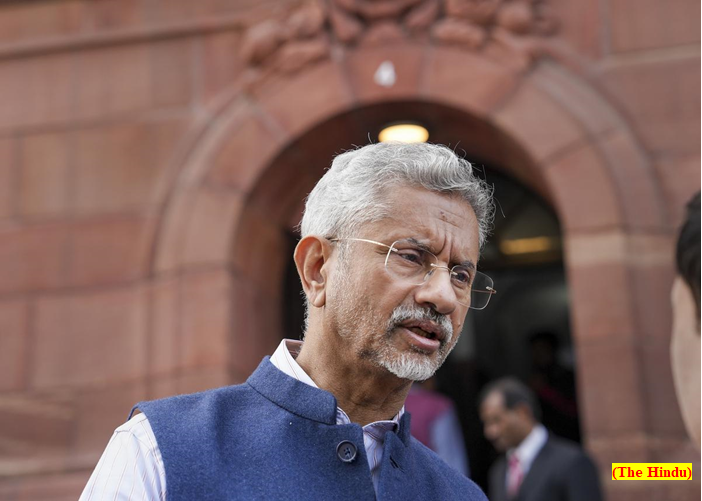Have there been changes in India’s foreign policy (GS Paper 2, International Relation)

Context:
- By all standards, 2022 was a difficult year on the geopolitical and diplomatic stage, especially after Russia’s invasion of Ukraine in February. For India, the choices grew more difficult, given its strategic ties with the U.S. and Europe and traditional ties with Russia.
- The most significant defence of India’s foreign policy was made by External Affairs Minister S. Jaishankar, who won accolades back home for calling out western “hypocrisy” on Russian oil flows to India.
- However, the government continues to take criticism over its China policy and the stand-off at the Line of Actual Control.
How did India handle the Ukraine crisis?
- The war in Ukraine saw the government spell out its version of “non-alignment”, as it sought to keep a balance in the growing polarisation between the U.S. and the European Union on one side, and Russia on the other.
- In the past 10 months, the war has led to thousands of deaths, and nearly 8 million refugees fleeing the country. Meanwhile, a slew of sanctions by the West meant to target the Russian economy led to food and fuel shortages and price increases, which worried India.
- The government’s stand through the year was a tough tight-rope walk: with the Prime Minister making his discomfort with the war clear directly to Russian President Vladimir Putin with the words “This era is not for war”, that became a catchphrase for the West, but at the same time refusing to accept western sanctions, growing military and oil trade with Russia, and seeking rupee-based payment mechanisms to facilitate them.
- Most significantly, in more than a dozen resolutions at the UNSC, UNGA, IAEA, Human Rights Commission, and other multilateral platforms seeking to censure Russia for the invasion and humanitarian crisis, India chose to abstain.
What were the other highlights in foreign policy in 2022?
- The year was marked in many ways for Indian diplomacy, which will be at the forefront in 2023, during India’s presidency of the G-20 and chairship of the Shanghai Cooperation Organisation (SCO), which will bring all the major leaders of the world to Delhi for summits.
- In 2022, India returned to Free Trade Agreements, after a hiatus of several years when the Modi government had called for a review of all FTAs, scrapped all Bilateral Investment Treaties (BITs) and walked out of the 15-nation Asian Regional Comprehensive Economic Partnership (RCEP).
- In 2022, India signed trade agreements with the UAE and Australia, and hopes to progress on talks with the EU, Gulf Cooperation Council and Canada for others.
- India also joined the U.S.-led Indo-Pacific Economic Forum (IPEF), although it later decided to stay out of trade talks.
- At the G-20, India is expected to highlight climate change transitions, “women-led” development and multilateral reform, among other key issues.
What about ties with neighbours?
- In the neighbourhood, India’s foreign policy was marked by economic assistance to Sri Lanka in the midst of its collapse, and regional trade and energy agreements with Bangladesh, Bhutan, and Nepal that could see a South Asian energy grid emerge.
- India has also strengthened ties with Central Asian countries on connectivity. The government kept channels open with repressive regimes like Afghanistan’s Taliban and the Myanmar Junta, opening a “technical mission” in Kabul and sending the foreign secretary to Nay Pyi Taw to discuss border cooperation.
- Recently, India abstained on a UNSC vote calling for Myanmar to end violence and release political prisoners.
- With Iran too, where protests against the killing of activist Mahsa Amini have brought thousands onto the streets, India has steered clear of any criticism.
- However, with Pakistan, ties remain flat-lined, with a big showdown at the UN between Foreign Minister of both countries.
Has there been any progress on the LAC stand-off with China?
- Despite a visit to Delhi by China’s Foreign Minister and disengagement at some stand-off points, India-China tensions at the Line of Actual Control remained high, and the year ended with an unsuccessful Chinese PLA attempt to take Indian posts at Yangtse in Arunachal Pradesh, signalling more such violent clashes could follow in 2023.
- The government took some heat from the Opposition over its failure to hold an open debate in Parliament to discuss the LAC stand-off that has been ongoing since April 2020, especially after Prime Minister shook hands with Chinese President at the Bali G20 meet in November.
- Regardless of the fraught state of ties, India is due to host Mr. Xi twice in 2023, at the G-20 and SCO summits, which could create opportunities for talks to end the stand-off.


